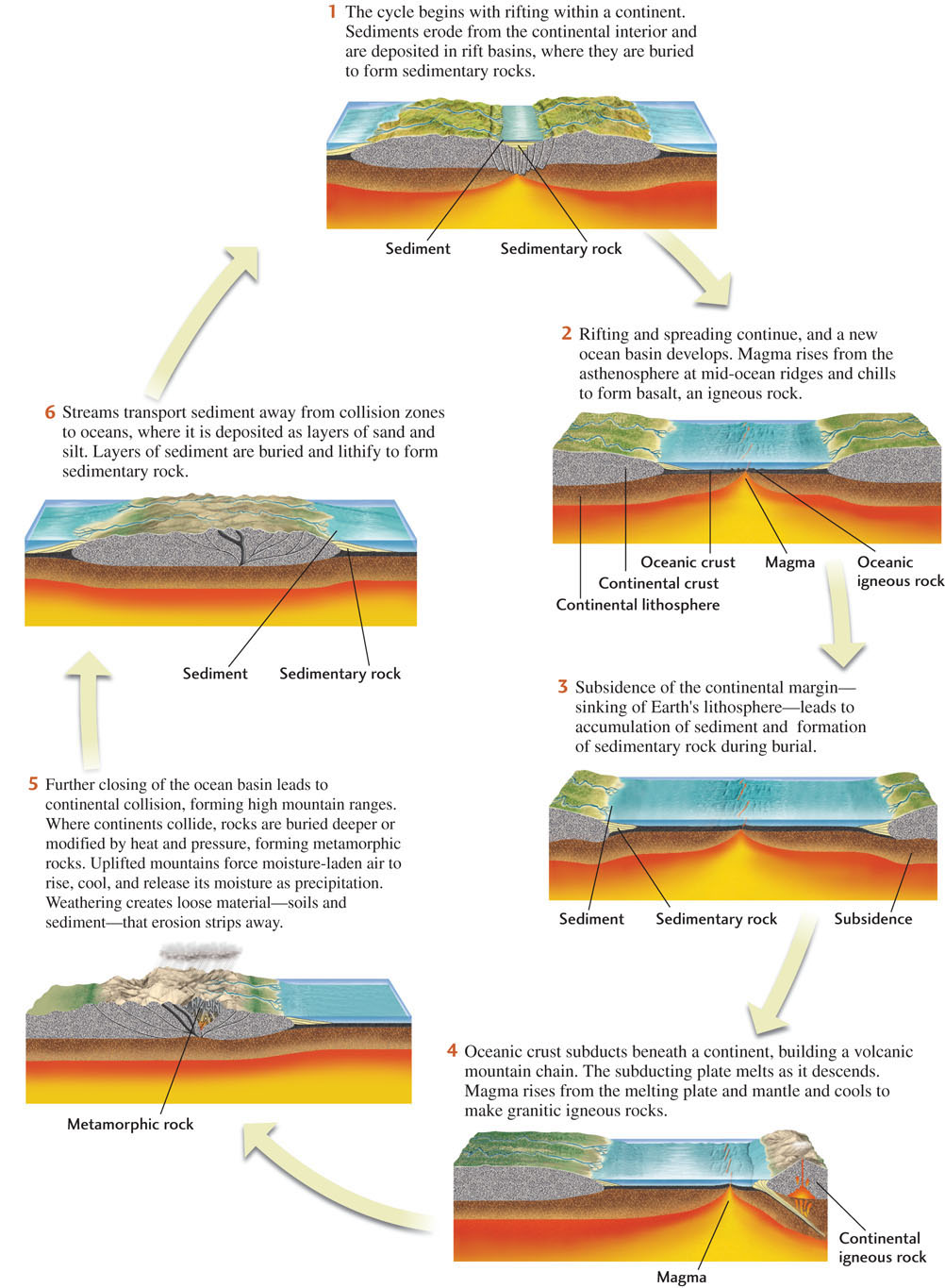The Rock Cycle: Interactions Between the Plate Tectonic and Climate Systems
Earth scientists have known for over 200 years that the three families of rocks—igneous, metamorphic, and sedimentary—all can evolve from one to another. Their observations gave rise to the concept of a rock cycle, which explains how each type of rock is transformed into one of the other two types. The rock cycle is now known to be the result of interactions between two of the three global geosystems: the plate tectonic system and the climate system. Interactions between these two geosystems drive transfers of materials and energy among Earth’s interior, the land surface, the ocean, and the atmosphere. For example, the formation of magmas at subduction zones results from processes operating within the plate tectonic system. When these magmas erupt, materials and energy are transferred to the land surface, where the materials (newly formed rocks) are subject to weathering by the climate system. The eruption process also injects volcanic ash and carbon dioxide gas high into the atmosphere, where they may affect global climates. As global climates change, perhaps becoming warmer or cooler, the rate of weathering changes, which in turn influences the rate at which materials (sediments) are returned to Earth’s interior.
Let’s trace one turn of the rock cycle, beginning with the creation of new oceanic lithosphere at a mid-ocean ridge spreading center as two continents drift apart (Figure 3.28). The ocean gets wider and wider, until at some point the process reverses itself and the ocean closes. As the ocean basin closes, igneous rocks created at the mid-ocean ridge are eventually subducted beneath a continent. Sediments that were formed on the continent and deposited at its edge may also be dragged down into the subduction zone. Ultimately, the two continents, which were once drifting apart, may collide. As the igneous rocks and sediments that descend into the subduction zone go deeper and deeper into Earth’s interior, they begin to melt to form a new generation of igneous rocks. The great heat associated with the intrusion of these igneous rocks, coupled with the heat and pressure that come with being pushed to levels deep within Earth, transforms these igneous rocks—and other surrounding rocks—into metamorphic rocks. When the continents collide, these igneous and metamorphic rocks are uplifted into a high mountain chain as a section of Earth’s crust crumples, deforms, and undergoes further metamorphism.

The rocks of the uplifted mountains are exposed to the influences of the climate system, but they affect the climate system in turn, forcing moving air to rise, cool, and release precipitation. The rocks are slowly weathered, forming loose materials that erosion then strips away. Water and wind transport some of these materials across the continent and eventually to the edges of the continent, where they are deposited as sediments. The sediments laid down where the land meets the ocean are buried under successive layers of sediments, where they slowly lithify into sedimentary rock. These oceans, like those mentioned at the beginning of the cycle, were probably formed by seafloor spreading along mid-ocean ridges, thus completing the rock cycle.
The particular pathway illustrated here—that of a continent breaking apart, forming a new ocean basin, then closing back up again—is only one variation among many that may take place in the rock cycle. Any type of rock—igneous, sedimentary, or metamorphic—can be uplifted during a mountain-building event and then weathered and eroded to form new sediments. Some stages may be omitted: as a sedimentary rock is uplifted and eroded, for example, metamorphism and melting are skipped. In some cases, the rock cycle proceeds very slowly. For example, we know that some igneous and metamorphic rocks many kilometers deep in the crust may be uplifted or exposed to weathering and erosion only after billions of years have passed.
The rock cycle never ends. It is always operating at different stages in various parts of the world, forming and eroding mountains in one place and laying down and burying sediments in another. The rocks that make up the solid Earth are recycled continuously, but we can see only the surface parts of the cycle. We must deduce the recycling of the deep crust and the mantle from indirect evidence.
80
81